Energy Sustainability: COP21 Challenges, Fracking LCA & Policy Impacts
VerifiedAdded on 2023/01/18
|23
|6057
|1
Report
AI Summary
This report comprehensively analyzes energy sustainability, starting with the challenges arising from the COP21 decision, including reconciling top-down goals with Nationally Determined Contributions and establishing effective climate finance mechanisms. It assesses the life cycle environmental, social, and economic sustainability of shale gas production and use in the United States and the UK, focusing on the impacts of fracking activities. The report also examines political and financial incentives for implementing energy efficiency measures in the housing and transport sectors in Sweden, the United States, and China. Finally, it critically evaluates the social, financial, and environmental impacts of developing renewable energy technologies in the United States, providing recommendations for improving environmental protection and promoting clean energy sources. Desklib offers a platform for students to access this and many other solved assignments.
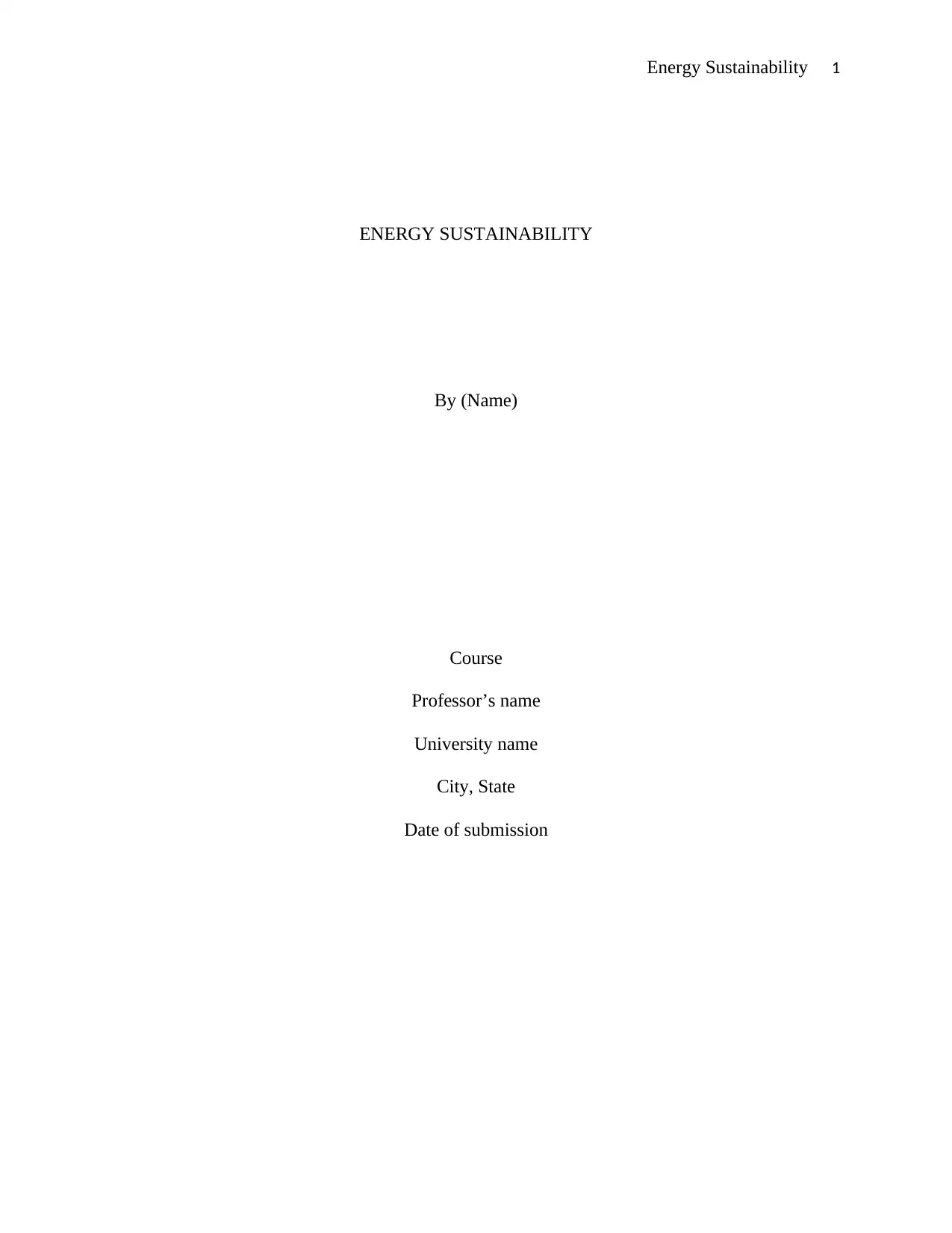
Energy Sustainability 1
ENERGY SUSTAINABILITY
By (Name)
Course
Professor’s name
University name
City, State
Date of submission
ENERGY SUSTAINABILITY
By (Name)
Course
Professor’s name
University name
City, State
Date of submission
Paraphrase This Document
Need a fresh take? Get an instant paraphrase of this document with our AI Paraphraser
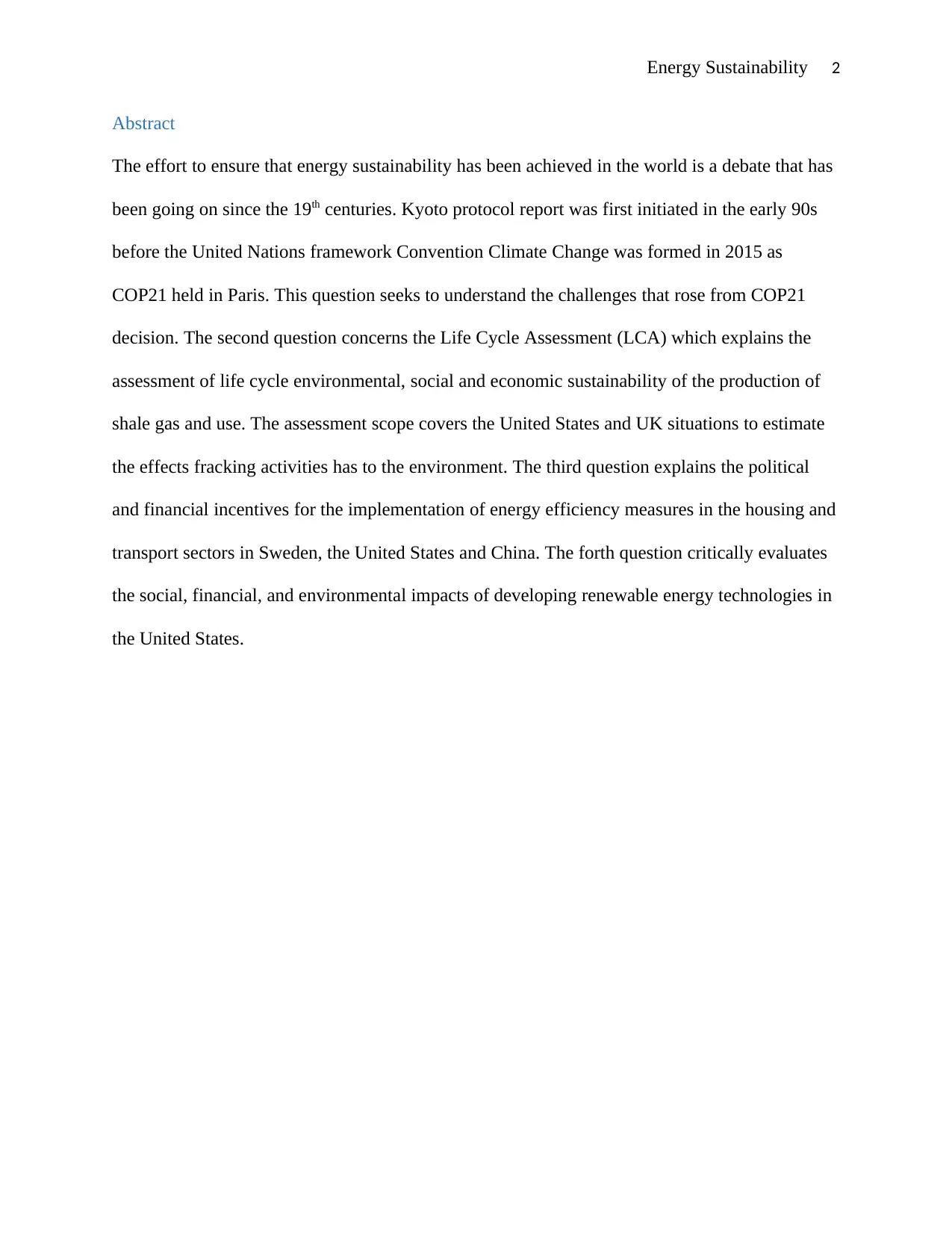
Energy Sustainability 2
Abstract
The effort to ensure that energy sustainability has been achieved in the world is a debate that has
been going on since the 19th centuries. Kyoto protocol report was first initiated in the early 90s
before the United Nations framework Convention Climate Change was formed in 2015 as
COP21 held in Paris. This question seeks to understand the challenges that rose from COP21
decision. The second question concerns the Life Cycle Assessment (LCA) which explains the
assessment of life cycle environmental, social and economic sustainability of the production of
shale gas and use. The assessment scope covers the United States and UK situations to estimate
the effects fracking activities has to the environment. The third question explains the political
and financial incentives for the implementation of energy efficiency measures in the housing and
transport sectors in Sweden, the United States and China. The forth question critically evaluates
the social, financial, and environmental impacts of developing renewable energy technologies in
the United States.
Abstract
The effort to ensure that energy sustainability has been achieved in the world is a debate that has
been going on since the 19th centuries. Kyoto protocol report was first initiated in the early 90s
before the United Nations framework Convention Climate Change was formed in 2015 as
COP21 held in Paris. This question seeks to understand the challenges that rose from COP21
decision. The second question concerns the Life Cycle Assessment (LCA) which explains the
assessment of life cycle environmental, social and economic sustainability of the production of
shale gas and use. The assessment scope covers the United States and UK situations to estimate
the effects fracking activities has to the environment. The third question explains the political
and financial incentives for the implementation of energy efficiency measures in the housing and
transport sectors in Sweden, the United States and China. The forth question critically evaluates
the social, financial, and environmental impacts of developing renewable energy technologies in
the United States.
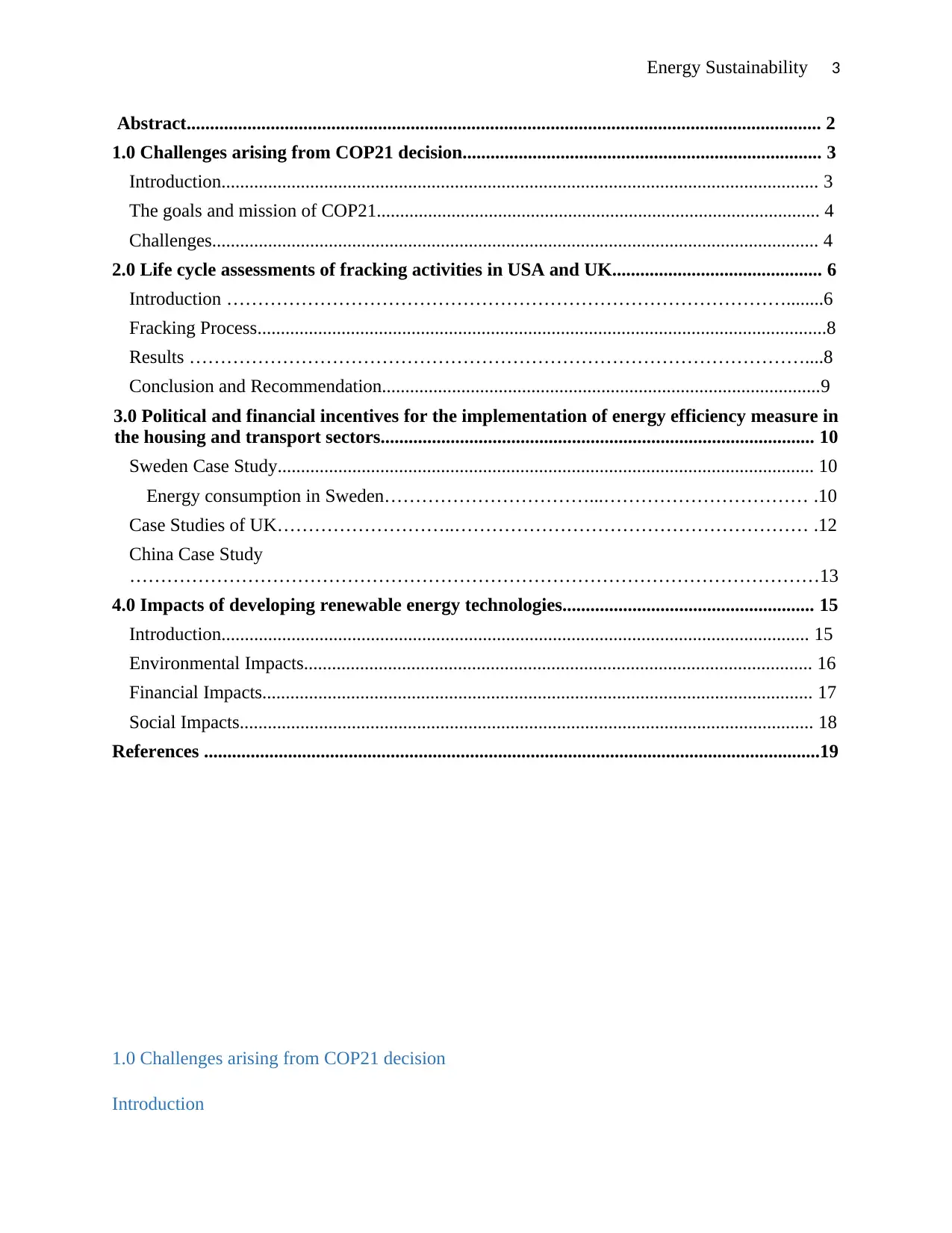
Energy Sustainability 3
Abstract........................................................................................................................................ 2
1.0 Challenges arising from COP21 decision............................................................................. 3
Introduction................................................................................................................................ 3
The goals and mission of COP21............................................................................................... 4
Challenges.................................................................................................................................. 4
2.0 Life cycle assessments of fracking activities in USA and UK............................................. 6
Introduction ………………………………………………………………………………........6
Fracking Process..........................................................................................................................8
Results ………………………………………………………………………………………....8
Conclusion and Recommendation..............................................................................................9
3.0 Political and financial incentives for the implementation of energy efficiency measure in
the housing and transport sectors............................................................................................. 10
Sweden Case Study................................................................................................................... 10
Energy consumption in Sweden……………………………...…………………………… .10
Case Studies of UK………………………..………………………………………………… .12
China Case Study
…………………………………………………………………………………………………13
4.0 Impacts of developing renewable energy technologies...................................................... 15
Introduction.............................................................................................................................. 15
Environmental Impacts............................................................................................................. 16
Financial Impacts...................................................................................................................... 17
Social Impacts........................................................................................................................... 18
References ....................................................................................................................................19
1.0 Challenges arising from COP21 decision
Introduction
Abstract........................................................................................................................................ 2
1.0 Challenges arising from COP21 decision............................................................................. 3
Introduction................................................................................................................................ 3
The goals and mission of COP21............................................................................................... 4
Challenges.................................................................................................................................. 4
2.0 Life cycle assessments of fracking activities in USA and UK............................................. 6
Introduction ………………………………………………………………………………........6
Fracking Process..........................................................................................................................8
Results ………………………………………………………………………………………....8
Conclusion and Recommendation..............................................................................................9
3.0 Political and financial incentives for the implementation of energy efficiency measure in
the housing and transport sectors............................................................................................. 10
Sweden Case Study................................................................................................................... 10
Energy consumption in Sweden……………………………...…………………………… .10
Case Studies of UK………………………..………………………………………………… .12
China Case Study
…………………………………………………………………………………………………13
4.0 Impacts of developing renewable energy technologies...................................................... 15
Introduction.............................................................................................................................. 15
Environmental Impacts............................................................................................................. 16
Financial Impacts...................................................................................................................... 17
Social Impacts........................................................................................................................... 18
References ....................................................................................................................................19
1.0 Challenges arising from COP21 decision
Introduction
⊘ This is a preview!⊘
Do you want full access?
Subscribe today to unlock all pages.

Trusted by 1+ million students worldwide
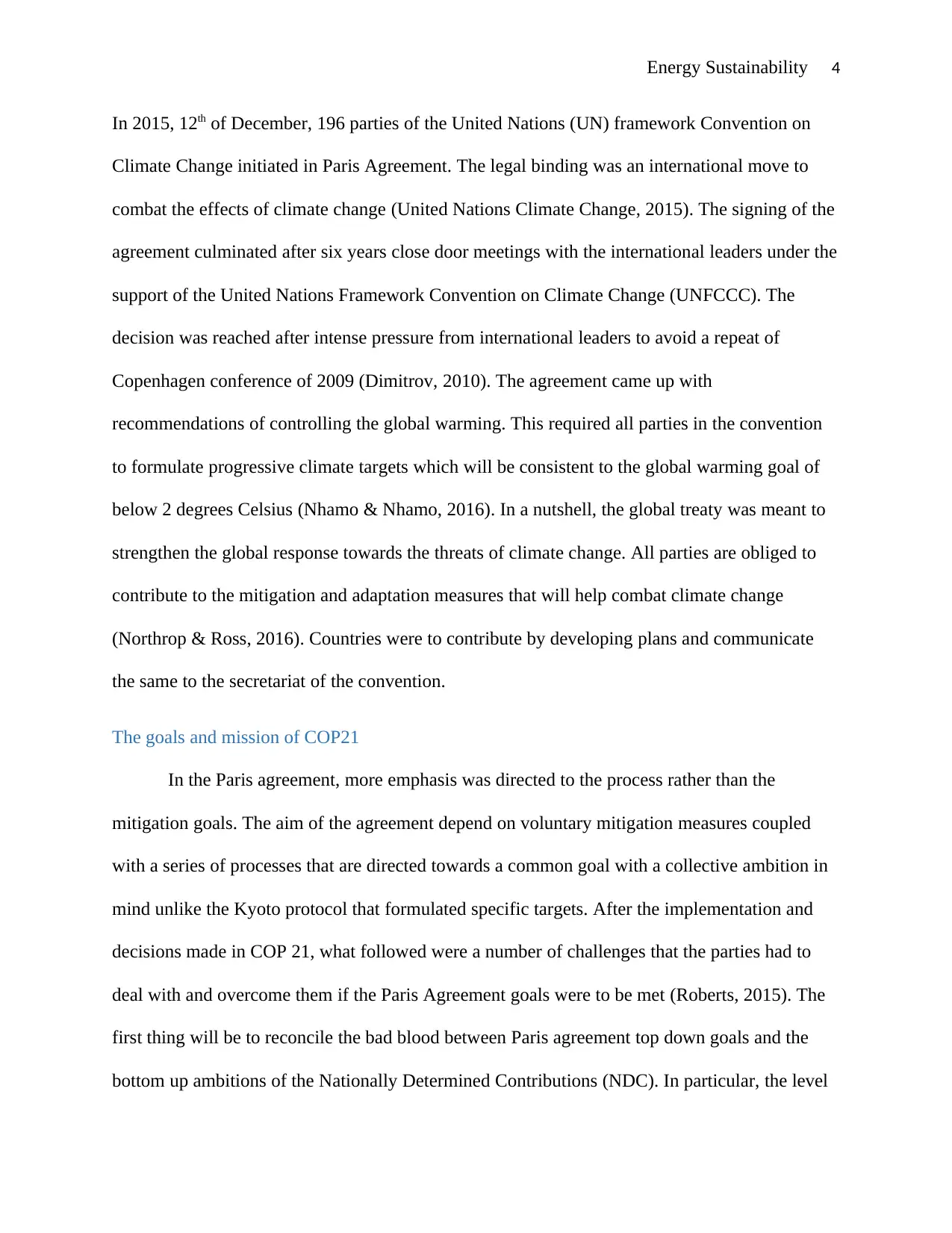
Energy Sustainability 4
In 2015, 12th of December, 196 parties of the United Nations (UN) framework Convention on
Climate Change initiated in Paris Agreement. The legal binding was an international move to
combat the effects of climate change (United Nations Climate Change, 2015). The signing of the
agreement culminated after six years close door meetings with the international leaders under the
support of the United Nations Framework Convention on Climate Change (UNFCCC). The
decision was reached after intense pressure from international leaders to avoid a repeat of
Copenhagen conference of 2009 (Dimitrov, 2010). The agreement came up with
recommendations of controlling the global warming. This required all parties in the convention
to formulate progressive climate targets which will be consistent to the global warming goal of
below 2 degrees Celsius (Nhamo & Nhamo, 2016). In a nutshell, the global treaty was meant to
strengthen the global response towards the threats of climate change. All parties are obliged to
contribute to the mitigation and adaptation measures that will help combat climate change
(Northrop & Ross, 2016). Countries were to contribute by developing plans and communicate
the same to the secretariat of the convention.
The goals and mission of COP21
In the Paris agreement, more emphasis was directed to the process rather than the
mitigation goals. The aim of the agreement depend on voluntary mitigation measures coupled
with a series of processes that are directed towards a common goal with a collective ambition in
mind unlike the Kyoto protocol that formulated specific targets. After the implementation and
decisions made in COP 21, what followed were a number of challenges that the parties had to
deal with and overcome them if the Paris Agreement goals were to be met (Roberts, 2015). The
first thing will be to reconcile the bad blood between Paris agreement top down goals and the
bottom up ambitions of the Nationally Determined Contributions (NDC). In particular, the level
In 2015, 12th of December, 196 parties of the United Nations (UN) framework Convention on
Climate Change initiated in Paris Agreement. The legal binding was an international move to
combat the effects of climate change (United Nations Climate Change, 2015). The signing of the
agreement culminated after six years close door meetings with the international leaders under the
support of the United Nations Framework Convention on Climate Change (UNFCCC). The
decision was reached after intense pressure from international leaders to avoid a repeat of
Copenhagen conference of 2009 (Dimitrov, 2010). The agreement came up with
recommendations of controlling the global warming. This required all parties in the convention
to formulate progressive climate targets which will be consistent to the global warming goal of
below 2 degrees Celsius (Nhamo & Nhamo, 2016). In a nutshell, the global treaty was meant to
strengthen the global response towards the threats of climate change. All parties are obliged to
contribute to the mitigation and adaptation measures that will help combat climate change
(Northrop & Ross, 2016). Countries were to contribute by developing plans and communicate
the same to the secretariat of the convention.
The goals and mission of COP21
In the Paris agreement, more emphasis was directed to the process rather than the
mitigation goals. The aim of the agreement depend on voluntary mitigation measures coupled
with a series of processes that are directed towards a common goal with a collective ambition in
mind unlike the Kyoto protocol that formulated specific targets. After the implementation and
decisions made in COP 21, what followed were a number of challenges that the parties had to
deal with and overcome them if the Paris Agreement goals were to be met (Roberts, 2015). The
first thing will be to reconcile the bad blood between Paris agreement top down goals and the
bottom up ambitions of the Nationally Determined Contributions (NDC). In particular, the level
Paraphrase This Document
Need a fresh take? Get an instant paraphrase of this document with our AI Paraphraser
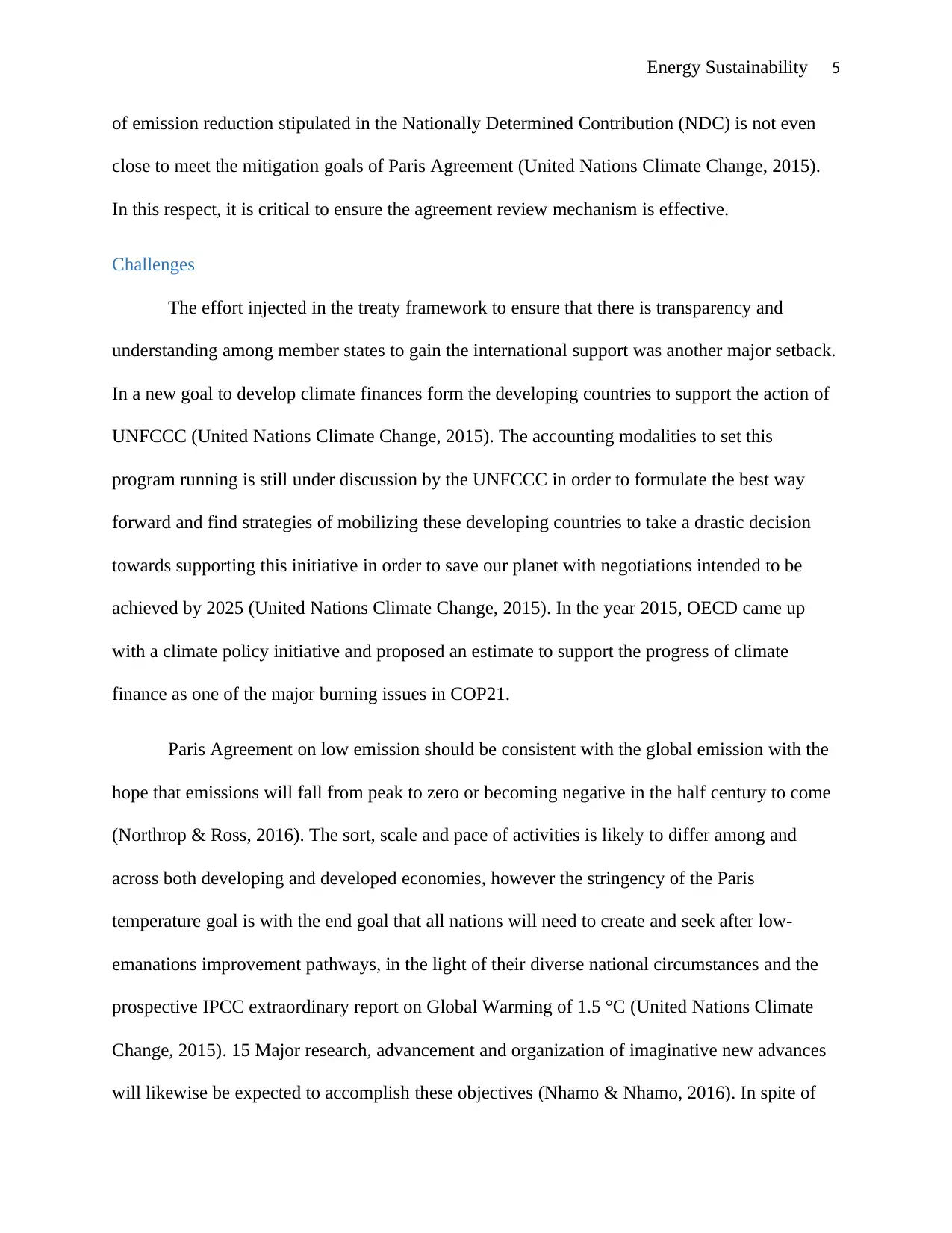
Energy Sustainability 5
of emission reduction stipulated in the Nationally Determined Contribution (NDC) is not even
close to meet the mitigation goals of Paris Agreement (United Nations Climate Change, 2015).
In this respect, it is critical to ensure the agreement review mechanism is effective.
Challenges
The effort injected in the treaty framework to ensure that there is transparency and
understanding among member states to gain the international support was another major setback.
In a new goal to develop climate finances form the developing countries to support the action of
UNFCCC (United Nations Climate Change, 2015). The accounting modalities to set this
program running is still under discussion by the UNFCCC in order to formulate the best way
forward and find strategies of mobilizing these developing countries to take a drastic decision
towards supporting this initiative in order to save our planet with negotiations intended to be
achieved by 2025 (United Nations Climate Change, 2015). In the year 2015, OECD came up
with a climate policy initiative and proposed an estimate to support the progress of climate
finance as one of the major burning issues in COP21.
Paris Agreement on low emission should be consistent with the global emission with the
hope that emissions will fall from peak to zero or becoming negative in the half century to come
(Northrop & Ross, 2016). The sort, scale and pace of activities is likely to differ among and
across both developing and developed economies, however the stringency of the Paris
temperature goal is with the end goal that all nations will need to create and seek after low-
emanations improvement pathways, in the light of their diverse national circumstances and the
prospective IPCC extraordinary report on Global Warming of 1.5 °C (United Nations Climate
Change, 2015). 15 Major research, advancement and organization of imaginative new advances
will likewise be expected to accomplish these objectives (Nhamo & Nhamo, 2016). In spite of
of emission reduction stipulated in the Nationally Determined Contribution (NDC) is not even
close to meet the mitigation goals of Paris Agreement (United Nations Climate Change, 2015).
In this respect, it is critical to ensure the agreement review mechanism is effective.
Challenges
The effort injected in the treaty framework to ensure that there is transparency and
understanding among member states to gain the international support was another major setback.
In a new goal to develop climate finances form the developing countries to support the action of
UNFCCC (United Nations Climate Change, 2015). The accounting modalities to set this
program running is still under discussion by the UNFCCC in order to formulate the best way
forward and find strategies of mobilizing these developing countries to take a drastic decision
towards supporting this initiative in order to save our planet with negotiations intended to be
achieved by 2025 (United Nations Climate Change, 2015). In the year 2015, OECD came up
with a climate policy initiative and proposed an estimate to support the progress of climate
finance as one of the major burning issues in COP21.
Paris Agreement on low emission should be consistent with the global emission with the
hope that emissions will fall from peak to zero or becoming negative in the half century to come
(Northrop & Ross, 2016). The sort, scale and pace of activities is likely to differ among and
across both developing and developed economies, however the stringency of the Paris
temperature goal is with the end goal that all nations will need to create and seek after low-
emanations improvement pathways, in the light of their diverse national circumstances and the
prospective IPCC extraordinary report on Global Warming of 1.5 °C (United Nations Climate
Change, 2015). 15 Major research, advancement and organization of imaginative new advances
will likewise be expected to accomplish these objectives (Nhamo & Nhamo, 2016). In spite of
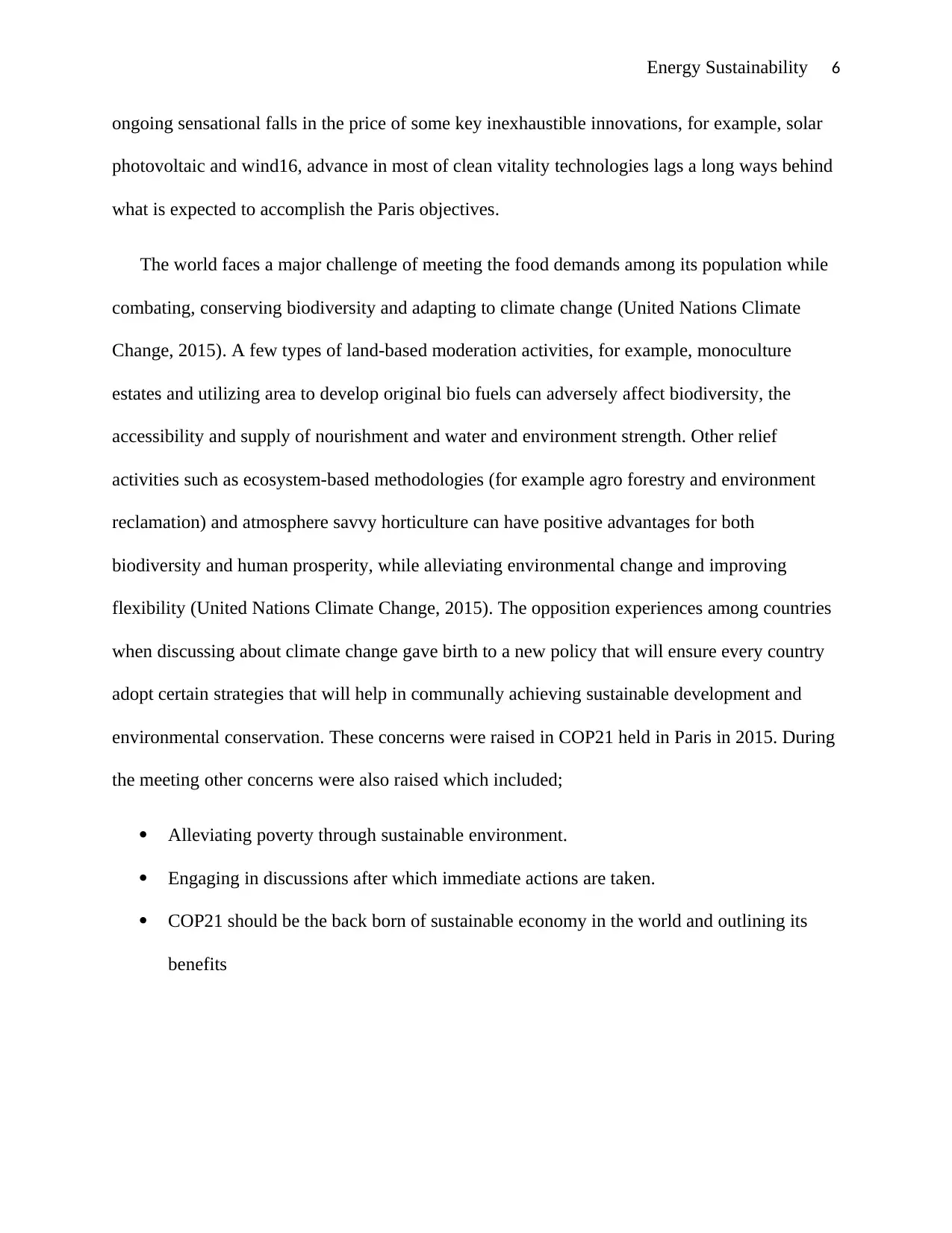
Energy Sustainability 6
ongoing sensational falls in the price of some key inexhaustible innovations, for example, solar
photovoltaic and wind16, advance in most of clean vitality technologies lags a long ways behind
what is expected to accomplish the Paris objectives.
The world faces a major challenge of meeting the food demands among its population while
combating, conserving biodiversity and adapting to climate change (United Nations Climate
Change, 2015). A few types of land-based moderation activities, for example, monoculture
estates and utilizing area to develop original bio fuels can adversely affect biodiversity, the
accessibility and supply of nourishment and water and environment strength. Other relief
activities such as ecosystem-based methodologies (for example agro forestry and environment
reclamation) and atmosphere savvy horticulture can have positive advantages for both
biodiversity and human prosperity, while alleviating environmental change and improving
flexibility (United Nations Climate Change, 2015). The opposition experiences among countries
when discussing about climate change gave birth to a new policy that will ensure every country
adopt certain strategies that will help in communally achieving sustainable development and
environmental conservation. These concerns were raised in COP21 held in Paris in 2015. During
the meeting other concerns were also raised which included;
Alleviating poverty through sustainable environment.
Engaging in discussions after which immediate actions are taken.
COP21 should be the back born of sustainable economy in the world and outlining its
benefits
ongoing sensational falls in the price of some key inexhaustible innovations, for example, solar
photovoltaic and wind16, advance in most of clean vitality technologies lags a long ways behind
what is expected to accomplish the Paris objectives.
The world faces a major challenge of meeting the food demands among its population while
combating, conserving biodiversity and adapting to climate change (United Nations Climate
Change, 2015). A few types of land-based moderation activities, for example, monoculture
estates and utilizing area to develop original bio fuels can adversely affect biodiversity, the
accessibility and supply of nourishment and water and environment strength. Other relief
activities such as ecosystem-based methodologies (for example agro forestry and environment
reclamation) and atmosphere savvy horticulture can have positive advantages for both
biodiversity and human prosperity, while alleviating environmental change and improving
flexibility (United Nations Climate Change, 2015). The opposition experiences among countries
when discussing about climate change gave birth to a new policy that will ensure every country
adopt certain strategies that will help in communally achieving sustainable development and
environmental conservation. These concerns were raised in COP21 held in Paris in 2015. During
the meeting other concerns were also raised which included;
Alleviating poverty through sustainable environment.
Engaging in discussions after which immediate actions are taken.
COP21 should be the back born of sustainable economy in the world and outlining its
benefits
⊘ This is a preview!⊘
Do you want full access?
Subscribe today to unlock all pages.

Trusted by 1+ million students worldwide
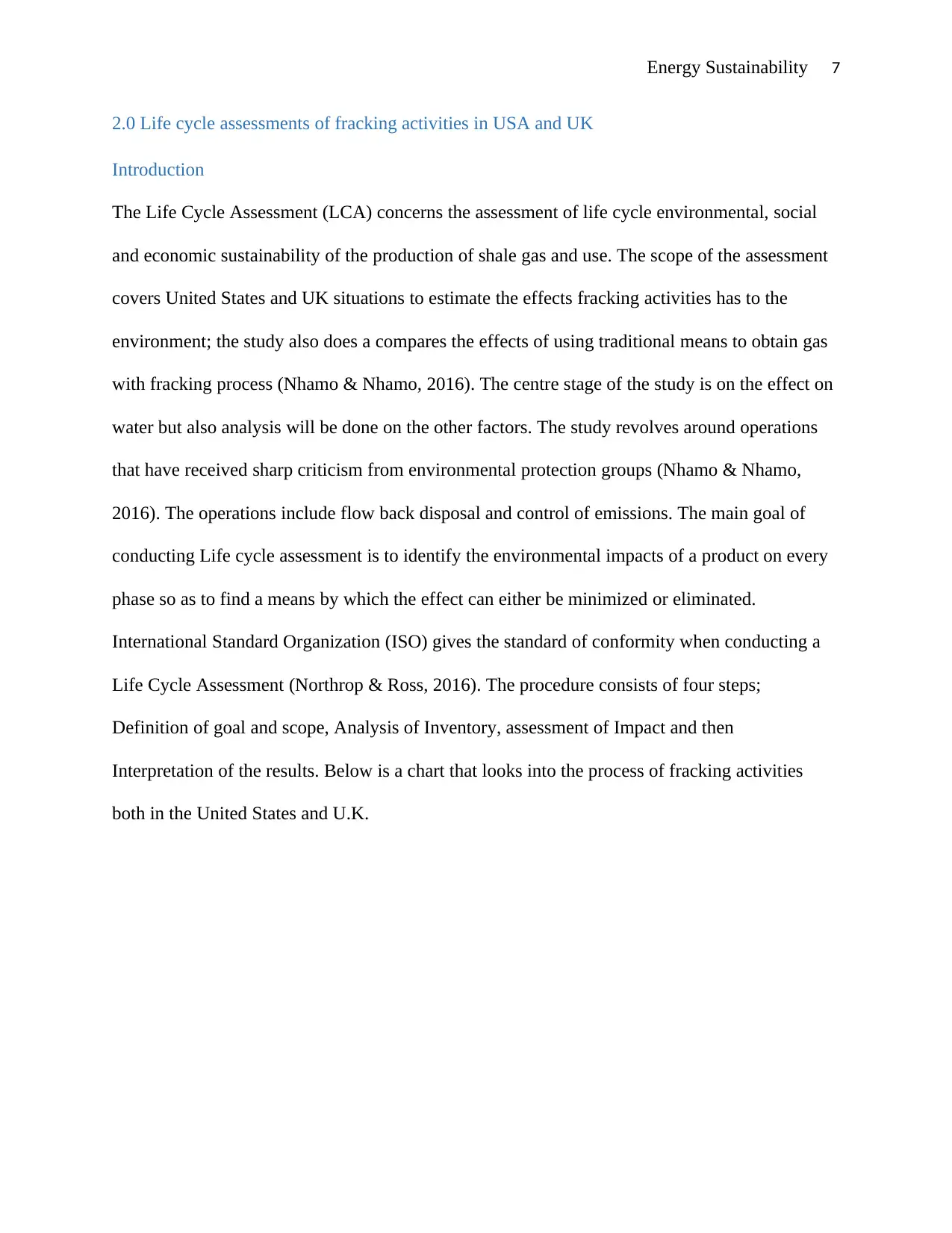
Energy Sustainability 7
2.0 Life cycle assessments of fracking activities in USA and UK
Introduction
The Life Cycle Assessment (LCA) concerns the assessment of life cycle environmental, social
and economic sustainability of the production of shale gas and use. The scope of the assessment
covers United States and UK situations to estimate the effects fracking activities has to the
environment; the study also does a compares the effects of using traditional means to obtain gas
with fracking process (Nhamo & Nhamo, 2016). The centre stage of the study is on the effect on
water but also analysis will be done on the other factors. The study revolves around operations
that have received sharp criticism from environmental protection groups (Nhamo & Nhamo,
2016). The operations include flow back disposal and control of emissions. The main goal of
conducting Life cycle assessment is to identify the environmental impacts of a product on every
phase so as to find a means by which the effect can either be minimized or eliminated.
International Standard Organization (ISO) gives the standard of conformity when conducting a
Life Cycle Assessment (Northrop & Ross, 2016). The procedure consists of four steps;
Definition of goal and scope, Analysis of Inventory, assessment of Impact and then
Interpretation of the results. Below is a chart that looks into the process of fracking activities
both in the United States and U.K.
2.0 Life cycle assessments of fracking activities in USA and UK
Introduction
The Life Cycle Assessment (LCA) concerns the assessment of life cycle environmental, social
and economic sustainability of the production of shale gas and use. The scope of the assessment
covers United States and UK situations to estimate the effects fracking activities has to the
environment; the study also does a compares the effects of using traditional means to obtain gas
with fracking process (Nhamo & Nhamo, 2016). The centre stage of the study is on the effect on
water but also analysis will be done on the other factors. The study revolves around operations
that have received sharp criticism from environmental protection groups (Nhamo & Nhamo,
2016). The operations include flow back disposal and control of emissions. The main goal of
conducting Life cycle assessment is to identify the environmental impacts of a product on every
phase so as to find a means by which the effect can either be minimized or eliminated.
International Standard Organization (ISO) gives the standard of conformity when conducting a
Life Cycle Assessment (Northrop & Ross, 2016). The procedure consists of four steps;
Definition of goal and scope, Analysis of Inventory, assessment of Impact and then
Interpretation of the results. Below is a chart that looks into the process of fracking activities
both in the United States and U.K.
Paraphrase This Document
Need a fresh take? Get an instant paraphrase of this document with our AI Paraphraser
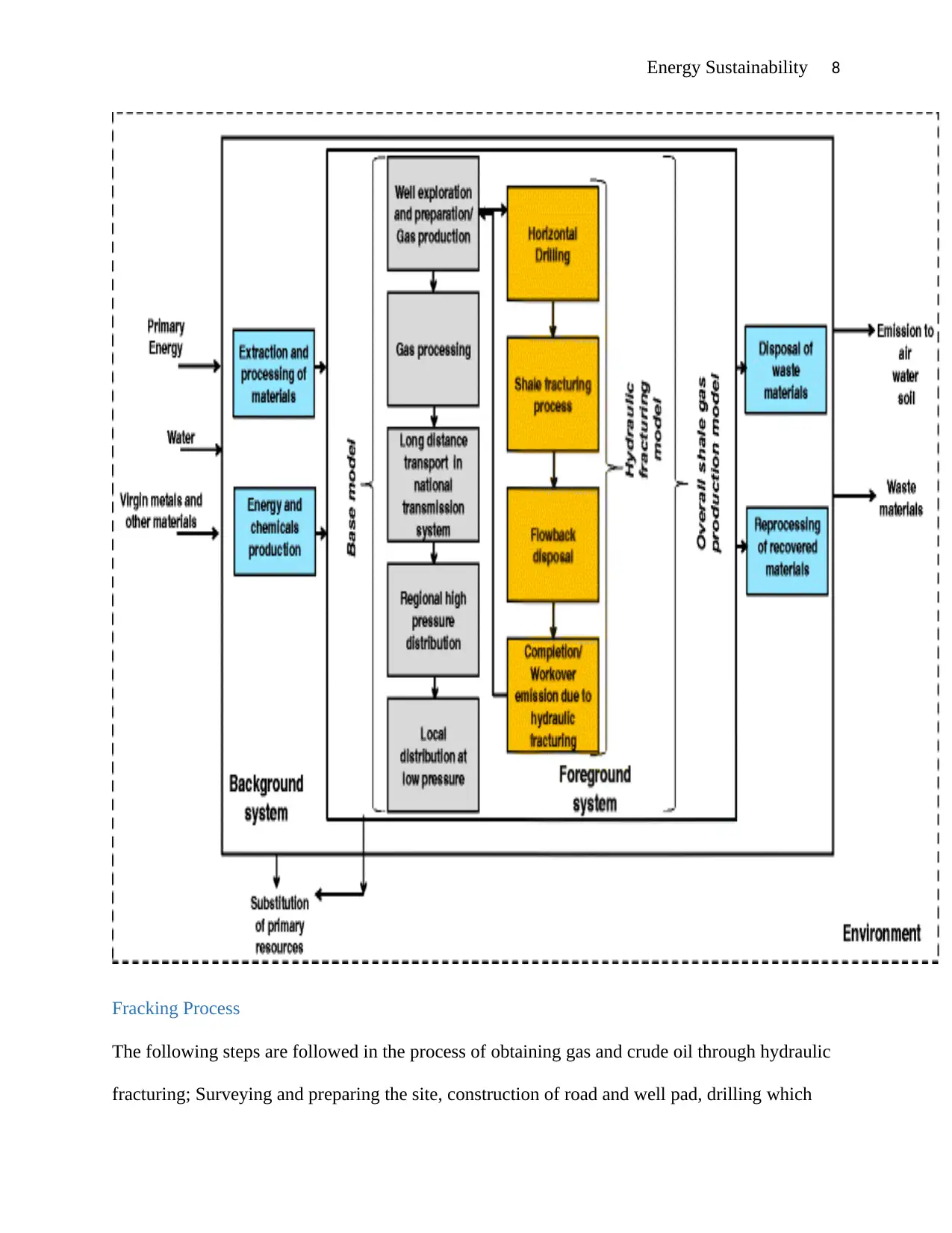
Energy Sustainability 8
Fracking Process
The following steps are followed in the process of obtaining gas and crude oil through hydraulic
fracturing; Surveying and preparing the site, construction of road and well pad, drilling which
Fracking Process
The following steps are followed in the process of obtaining gas and crude oil through hydraulic
fracturing; Surveying and preparing the site, construction of road and well pad, drilling which
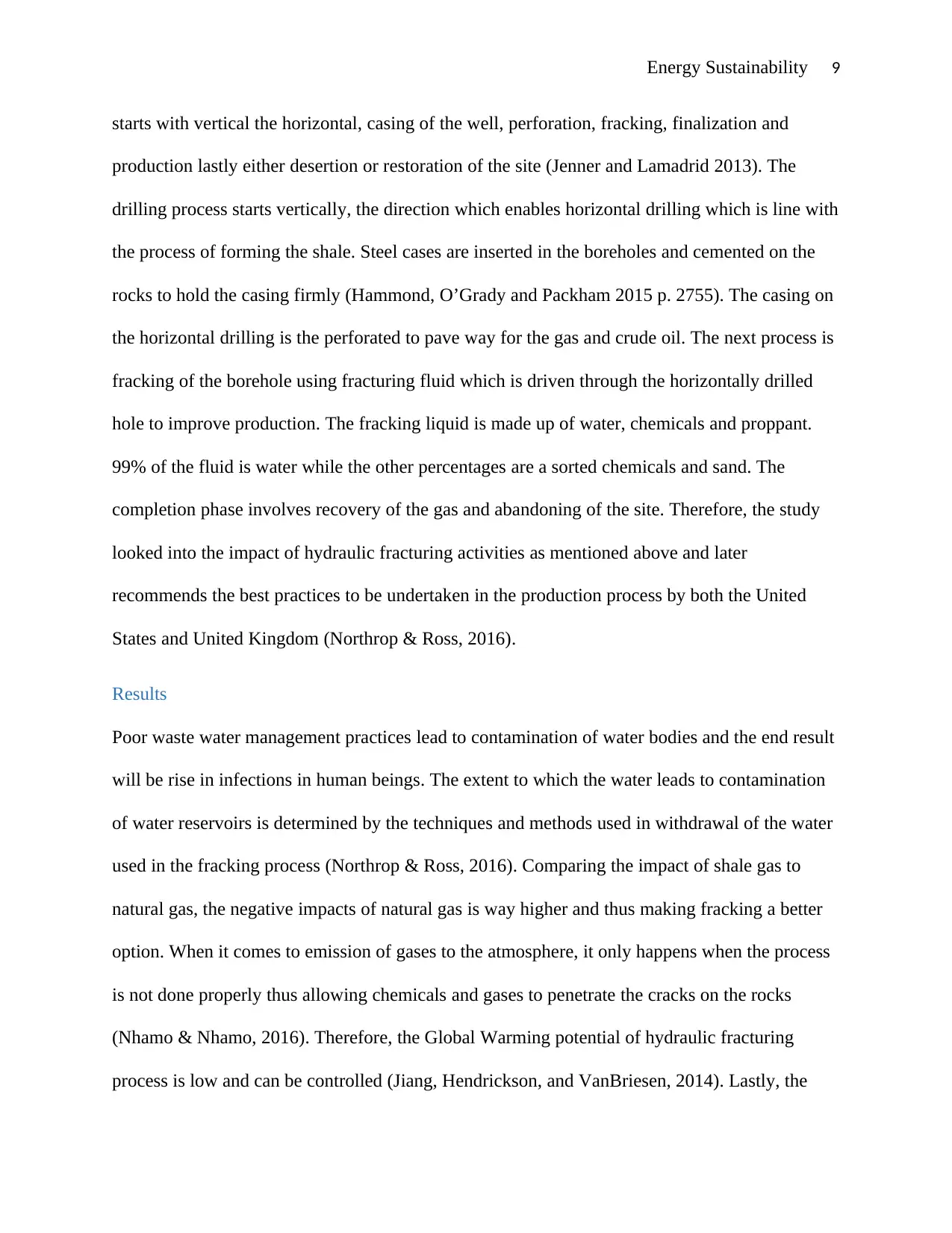
Energy Sustainability 9
starts with vertical the horizontal, casing of the well, perforation, fracking, finalization and
production lastly either desertion or restoration of the site (Jenner and Lamadrid 2013). The
drilling process starts vertically, the direction which enables horizontal drilling which is line with
the process of forming the shale. Steel cases are inserted in the boreholes and cemented on the
rocks to hold the casing firmly (Hammond, O’Grady and Packham 2015 p. 2755). The casing on
the horizontal drilling is the perforated to pave way for the gas and crude oil. The next process is
fracking of the borehole using fracturing fluid which is driven through the horizontally drilled
hole to improve production. The fracking liquid is made up of water, chemicals and proppant.
99% of the fluid is water while the other percentages are a sorted chemicals and sand. The
completion phase involves recovery of the gas and abandoning of the site. Therefore, the study
looked into the impact of hydraulic fracturing activities as mentioned above and later
recommends the best practices to be undertaken in the production process by both the United
States and United Kingdom (Northrop & Ross, 2016).
Results
Poor waste water management practices lead to contamination of water bodies and the end result
will be rise in infections in human beings. The extent to which the water leads to contamination
of water reservoirs is determined by the techniques and methods used in withdrawal of the water
used in the fracking process (Northrop & Ross, 2016). Comparing the impact of shale gas to
natural gas, the negative impacts of natural gas is way higher and thus making fracking a better
option. When it comes to emission of gases to the atmosphere, it only happens when the process
is not done properly thus allowing chemicals and gases to penetrate the cracks on the rocks
(Nhamo & Nhamo, 2016). Therefore, the Global Warming potential of hydraulic fracturing
process is low and can be controlled (Jiang, Hendrickson, and VanBriesen, 2014). Lastly, the
starts with vertical the horizontal, casing of the well, perforation, fracking, finalization and
production lastly either desertion or restoration of the site (Jenner and Lamadrid 2013). The
drilling process starts vertically, the direction which enables horizontal drilling which is line with
the process of forming the shale. Steel cases are inserted in the boreholes and cemented on the
rocks to hold the casing firmly (Hammond, O’Grady and Packham 2015 p. 2755). The casing on
the horizontal drilling is the perforated to pave way for the gas and crude oil. The next process is
fracking of the borehole using fracturing fluid which is driven through the horizontally drilled
hole to improve production. The fracking liquid is made up of water, chemicals and proppant.
99% of the fluid is water while the other percentages are a sorted chemicals and sand. The
completion phase involves recovery of the gas and abandoning of the site. Therefore, the study
looked into the impact of hydraulic fracturing activities as mentioned above and later
recommends the best practices to be undertaken in the production process by both the United
States and United Kingdom (Northrop & Ross, 2016).
Results
Poor waste water management practices lead to contamination of water bodies and the end result
will be rise in infections in human beings. The extent to which the water leads to contamination
of water reservoirs is determined by the techniques and methods used in withdrawal of the water
used in the fracking process (Northrop & Ross, 2016). Comparing the impact of shale gas to
natural gas, the negative impacts of natural gas is way higher and thus making fracking a better
option. When it comes to emission of gases to the atmosphere, it only happens when the process
is not done properly thus allowing chemicals and gases to penetrate the cracks on the rocks
(Nhamo & Nhamo, 2016). Therefore, the Global Warming potential of hydraulic fracturing
process is low and can be controlled (Jiang, Hendrickson, and VanBriesen, 2014). Lastly, the
⊘ This is a preview!⊘
Do you want full access?
Subscribe today to unlock all pages.

Trusted by 1+ million students worldwide
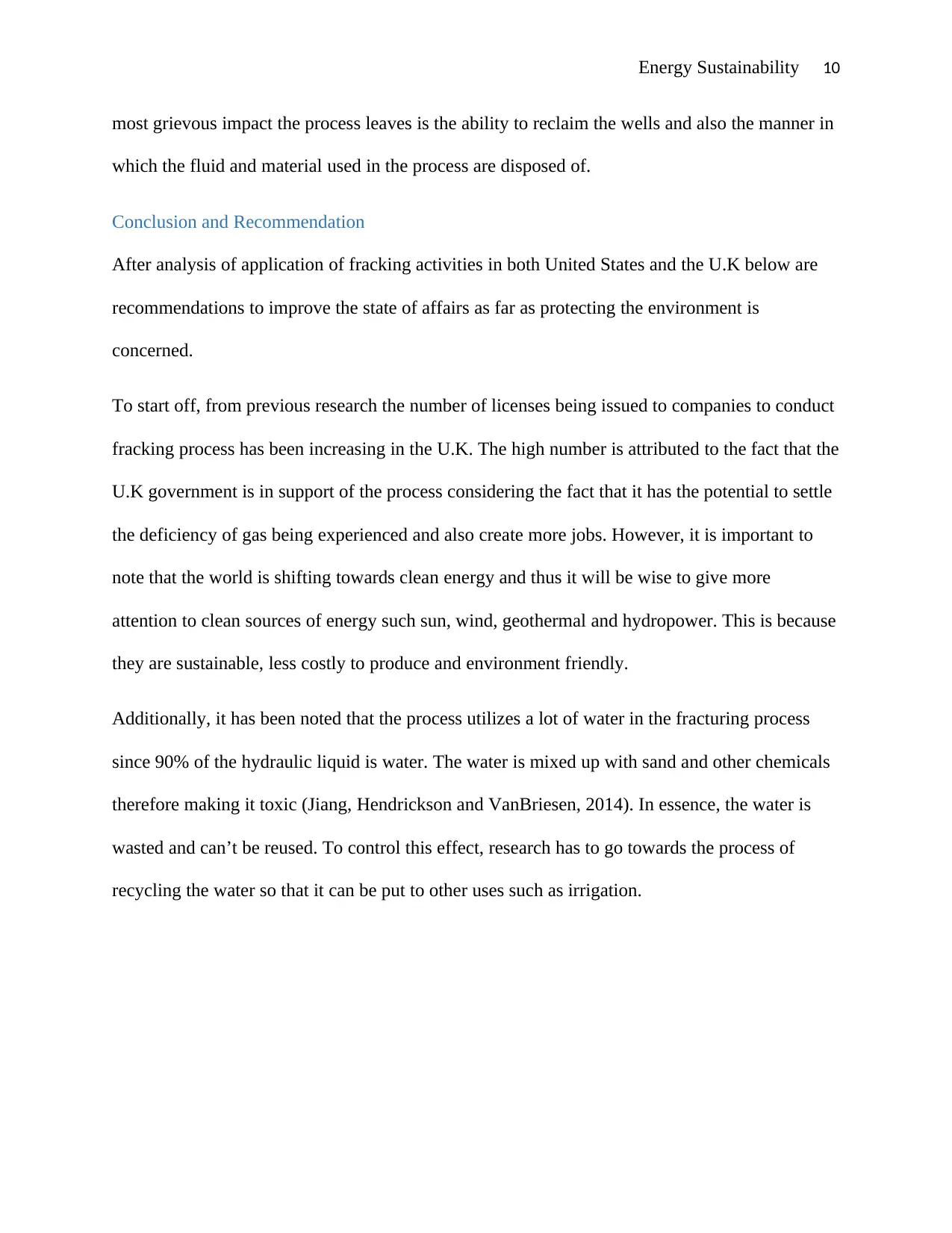
Energy Sustainability 10
most grievous impact the process leaves is the ability to reclaim the wells and also the manner in
which the fluid and material used in the process are disposed of.
Conclusion and Recommendation
After analysis of application of fracking activities in both United States and the U.K below are
recommendations to improve the state of affairs as far as protecting the environment is
concerned.
To start off, from previous research the number of licenses being issued to companies to conduct
fracking process has been increasing in the U.K. The high number is attributed to the fact that the
U.K government is in support of the process considering the fact that it has the potential to settle
the deficiency of gas being experienced and also create more jobs. However, it is important to
note that the world is shifting towards clean energy and thus it will be wise to give more
attention to clean sources of energy such sun, wind, geothermal and hydropower. This is because
they are sustainable, less costly to produce and environment friendly.
Additionally, it has been noted that the process utilizes a lot of water in the fracturing process
since 90% of the hydraulic liquid is water. The water is mixed up with sand and other chemicals
therefore making it toxic (Jiang, Hendrickson and VanBriesen, 2014). In essence, the water is
wasted and can’t be reused. To control this effect, research has to go towards the process of
recycling the water so that it can be put to other uses such as irrigation.
most grievous impact the process leaves is the ability to reclaim the wells and also the manner in
which the fluid and material used in the process are disposed of.
Conclusion and Recommendation
After analysis of application of fracking activities in both United States and the U.K below are
recommendations to improve the state of affairs as far as protecting the environment is
concerned.
To start off, from previous research the number of licenses being issued to companies to conduct
fracking process has been increasing in the U.K. The high number is attributed to the fact that the
U.K government is in support of the process considering the fact that it has the potential to settle
the deficiency of gas being experienced and also create more jobs. However, it is important to
note that the world is shifting towards clean energy and thus it will be wise to give more
attention to clean sources of energy such sun, wind, geothermal and hydropower. This is because
they are sustainable, less costly to produce and environment friendly.
Additionally, it has been noted that the process utilizes a lot of water in the fracturing process
since 90% of the hydraulic liquid is water. The water is mixed up with sand and other chemicals
therefore making it toxic (Jiang, Hendrickson and VanBriesen, 2014). In essence, the water is
wasted and can’t be reused. To control this effect, research has to go towards the process of
recycling the water so that it can be put to other uses such as irrigation.
Paraphrase This Document
Need a fresh take? Get an instant paraphrase of this document with our AI Paraphraser
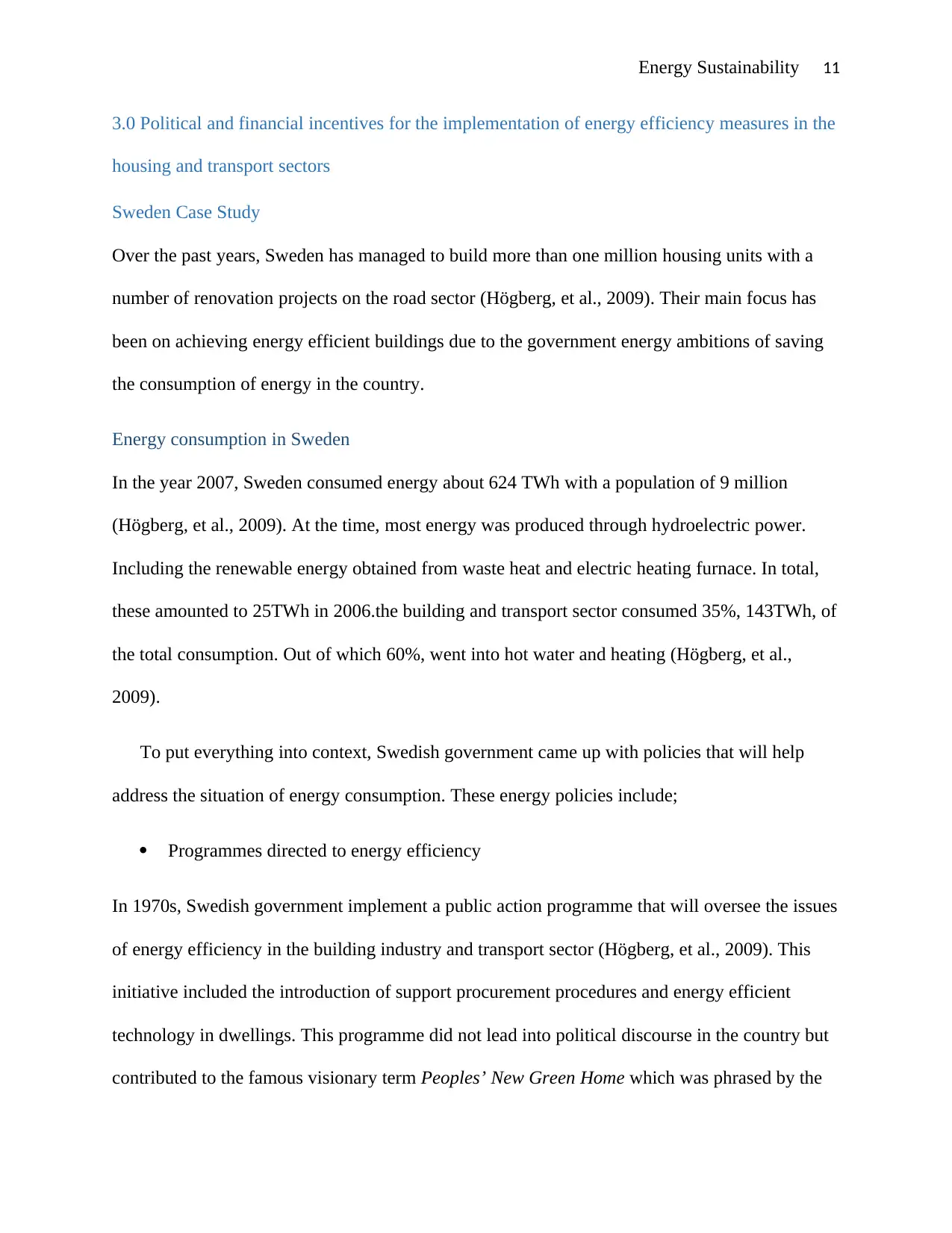
Energy Sustainability 11
3.0 Political and financial incentives for the implementation of energy efficiency measures in the
housing and transport sectors
Sweden Case Study
Over the past years, Sweden has managed to build more than one million housing units with a
number of renovation projects on the road sector (Högberg, et al., 2009). Their main focus has
been on achieving energy efficient buildings due to the government energy ambitions of saving
the consumption of energy in the country.
Energy consumption in Sweden
In the year 2007, Sweden consumed energy about 624 TWh with a population of 9 million
(Högberg, et al., 2009). At the time, most energy was produced through hydroelectric power.
Including the renewable energy obtained from waste heat and electric heating furnace. In total,
these amounted to 25TWh in 2006.the building and transport sector consumed 35%, 143TWh, of
the total consumption. Out of which 60%, went into hot water and heating (Högberg, et al.,
2009).
To put everything into context, Swedish government came up with policies that will help
address the situation of energy consumption. These energy policies include;
Programmes directed to energy efficiency
In 1970s, Swedish government implement a public action programme that will oversee the issues
of energy efficiency in the building industry and transport sector (Högberg, et al., 2009). This
initiative included the introduction of support procurement procedures and energy efficient
technology in dwellings. This programme did not lead into political discourse in the country but
contributed to the famous visionary term Peoples’ New Green Home which was phrased by the
3.0 Political and financial incentives for the implementation of energy efficiency measures in the
housing and transport sectors
Sweden Case Study
Over the past years, Sweden has managed to build more than one million housing units with a
number of renovation projects on the road sector (Högberg, et al., 2009). Their main focus has
been on achieving energy efficient buildings due to the government energy ambitions of saving
the consumption of energy in the country.
Energy consumption in Sweden
In the year 2007, Sweden consumed energy about 624 TWh with a population of 9 million
(Högberg, et al., 2009). At the time, most energy was produced through hydroelectric power.
Including the renewable energy obtained from waste heat and electric heating furnace. In total,
these amounted to 25TWh in 2006.the building and transport sector consumed 35%, 143TWh, of
the total consumption. Out of which 60%, went into hot water and heating (Högberg, et al.,
2009).
To put everything into context, Swedish government came up with policies that will help
address the situation of energy consumption. These energy policies include;
Programmes directed to energy efficiency
In 1970s, Swedish government implement a public action programme that will oversee the issues
of energy efficiency in the building industry and transport sector (Högberg, et al., 2009). This
initiative included the introduction of support procurement procedures and energy efficient
technology in dwellings. This programme did not lead into political discourse in the country but
contributed to the famous visionary term Peoples’ New Green Home which was phrased by the
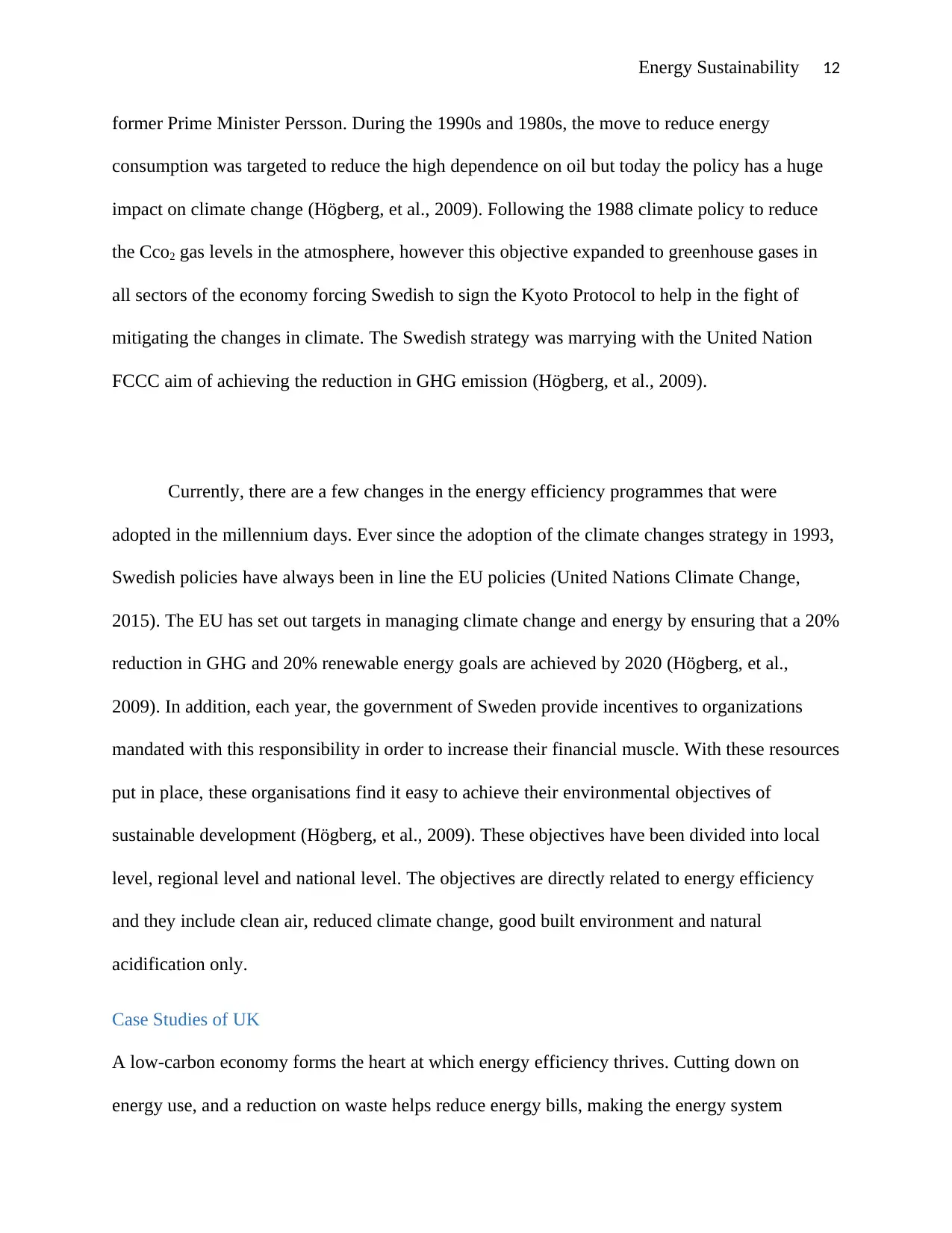
Energy Sustainability 12
former Prime Minister Persson. During the 1990s and 1980s, the move to reduce energy
consumption was targeted to reduce the high dependence on oil but today the policy has a huge
impact on climate change (Högberg, et al., 2009). Following the 1988 climate policy to reduce
the Cco2 gas levels in the atmosphere, however this objective expanded to greenhouse gases in
all sectors of the economy forcing Swedish to sign the Kyoto Protocol to help in the fight of
mitigating the changes in climate. The Swedish strategy was marrying with the United Nation
FCCC aim of achieving the reduction in GHG emission (Högberg, et al., 2009).
Currently, there are a few changes in the energy efficiency programmes that were
adopted in the millennium days. Ever since the adoption of the climate changes strategy in 1993,
Swedish policies have always been in line the EU policies (United Nations Climate Change,
2015). The EU has set out targets in managing climate change and energy by ensuring that a 20%
reduction in GHG and 20% renewable energy goals are achieved by 2020 (Högberg, et al.,
2009). In addition, each year, the government of Sweden provide incentives to organizations
mandated with this responsibility in order to increase their financial muscle. With these resources
put in place, these organisations find it easy to achieve their environmental objectives of
sustainable development (Högberg, et al., 2009). These objectives have been divided into local
level, regional level and national level. The objectives are directly related to energy efficiency
and they include clean air, reduced climate change, good built environment and natural
acidification only.
Case Studies of UK
A low-carbon economy forms the heart at which energy efficiency thrives. Cutting down on
energy use, and a reduction on waste helps reduce energy bills, making the energy system
former Prime Minister Persson. During the 1990s and 1980s, the move to reduce energy
consumption was targeted to reduce the high dependence on oil but today the policy has a huge
impact on climate change (Högberg, et al., 2009). Following the 1988 climate policy to reduce
the Cco2 gas levels in the atmosphere, however this objective expanded to greenhouse gases in
all sectors of the economy forcing Swedish to sign the Kyoto Protocol to help in the fight of
mitigating the changes in climate. The Swedish strategy was marrying with the United Nation
FCCC aim of achieving the reduction in GHG emission (Högberg, et al., 2009).
Currently, there are a few changes in the energy efficiency programmes that were
adopted in the millennium days. Ever since the adoption of the climate changes strategy in 1993,
Swedish policies have always been in line the EU policies (United Nations Climate Change,
2015). The EU has set out targets in managing climate change and energy by ensuring that a 20%
reduction in GHG and 20% renewable energy goals are achieved by 2020 (Högberg, et al.,
2009). In addition, each year, the government of Sweden provide incentives to organizations
mandated with this responsibility in order to increase their financial muscle. With these resources
put in place, these organisations find it easy to achieve their environmental objectives of
sustainable development (Högberg, et al., 2009). These objectives have been divided into local
level, regional level and national level. The objectives are directly related to energy efficiency
and they include clean air, reduced climate change, good built environment and natural
acidification only.
Case Studies of UK
A low-carbon economy forms the heart at which energy efficiency thrives. Cutting down on
energy use, and a reduction on waste helps reduce energy bills, making the energy system
⊘ This is a preview!⊘
Do you want full access?
Subscribe today to unlock all pages.

Trusted by 1+ million students worldwide
1 out of 23
Related Documents
Your All-in-One AI-Powered Toolkit for Academic Success.
+13062052269
info@desklib.com
Available 24*7 on WhatsApp / Email
![[object Object]](/_next/static/media/star-bottom.7253800d.svg)
Unlock your academic potential
Copyright © 2020–2025 A2Z Services. All Rights Reserved. Developed and managed by ZUCOL.





